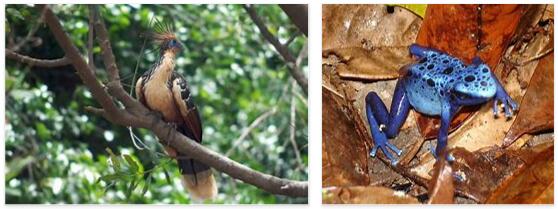Animals & Plants in Suriname
Most of Suriname is covered by rainforest, where the biodiversity is particularly great. Other plants and animals live on the coast. To protect its environment and biodiversity, Suriname has created eleven nature reserves, one nature park and four special environmental areas.
Which animals live in Suriname?
Suriname’s wildlife is very diverse. It wasn’t until 2013 that 60 previously unknown species were found. Flatland tapirs, armadillos, agoutis, peccaries and sloths can be found in the Suriname rainforest. The country’s predators include the jaguar, the puma, the ocelot, the coati, the raccoon, the wrapped bear, the forest dog and the tayra.
Anteaters like the great anteater, southern tamandua and pygmy anteater are looking for their favorite food – ants! Monkeys climb through the trees, for example howler monkeys, white-headed sakis, red-handed tamarins, red-faced spider monkeys, squirrel monkeys and capuchins. Frogs, toads, snakes and lizards are other inhabitants of the rainforest.
Many rivers run through Suriname. They are home to many species of fish, but also giant otters, capybaras (water pigs) and several species of caimans swim around here. Birds are also numerous, such as parrots, hummingbirds, and toucans. Noticeable species are also the scarlet ibis, the black vulture and the hoatzin.
An important breeding site for sea turtles can be found near Galibi at the mouth of the Marowijne River in the Atlantic. The four species that lay eggs here are the green sea turtle, the hawksbill sea turtle, the leatherback turtle, and the olive hybrid turtle.
Who was Maria Sibylla Merian?
Maria Sibylla Merian was born in Frankfurt am Main in 1647. She was a naturalist and artist. In 1699 she traveled to Suriname with her 21-year-old daughter Dorothea and explored the flora and fauna there. She was particularly interested in insects and especially butterflies. But she also observed and described toads, lizards, snakes, spiders and ants. She wrote a thick book about it, which she illustrated with copperplate engravings. It is called: Metamorphosis insectorum surinamensium. That is Latin and means: The metamorphosis of the insects in Suriname. Metamorphosis is the transformation from a young animal to an adult animal, for example the frog undergoes such a transformation and so do the butterflies. At the time of Maria Sibylla Merian this was pretty unknown. She also proved.
What is growing in Suriname?
Suriname is covered to a very large extent by rainforest, namely 80 percent. The biodiversity is particularly great there. Other plants and animals live on the coast. Of the eleven nature reserves, the Central Suriname Nature Reserve is the largest. It is a UNESCO World Heritage Site. To get more information on Suriname and South America, check animalerts.
There are more than 1000 tree species in the Suriname rainforest alone. This Surinamese rainforest is part of the Amazon rainforest. It is the largest contiguous rainforest on earth and is mostly in Brazil.
The Suriname rainforest, like that of other countries, is threatened because trees are felled to extract wood, create arable land, or create mines for bauxite or gold. The illegal (unlawful) gold mines also poison the environment because poisons such as mercury are used to loosen the gold from the rock.
Astrocaryum vulgare is a palm whose orange fruits can be eaten. Also to be found are the Mauritius palms and the Buriti palm. Their fruits can also be eaten. The kapok tree, the white gum tree and the jenipapo tree are also widespread. The West Indian cedar is considered endangered. The Surinam cherry bears its country of origin in its name. You can eat their fruits straight from the tree.
The sandbox tree with its spines on the trunk is quite striking. Its milky juice is very toxic. Among the plants, bromeliads and orchids in particular grow in many species. But you also feel comfortable in the trees. Each tree looks different as a result. Fern and fern moss are also native here. Black, white and red mangroves grow on the coast.
The heliconias are known for their pretty flowers. They also grow in Suriname. The heliconia scarlet lobster claw has even been named the country’s national flower. In Suriname it is also called Palulu.
